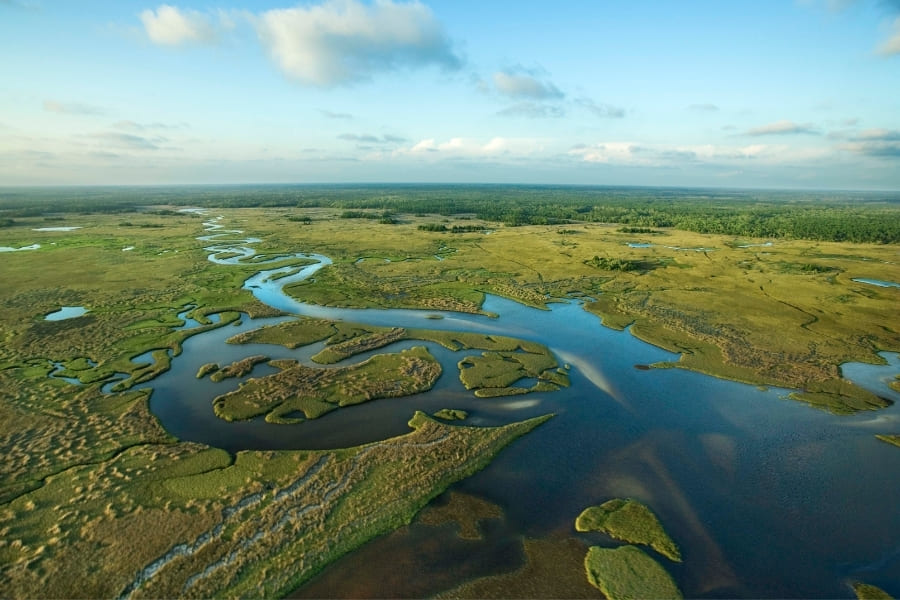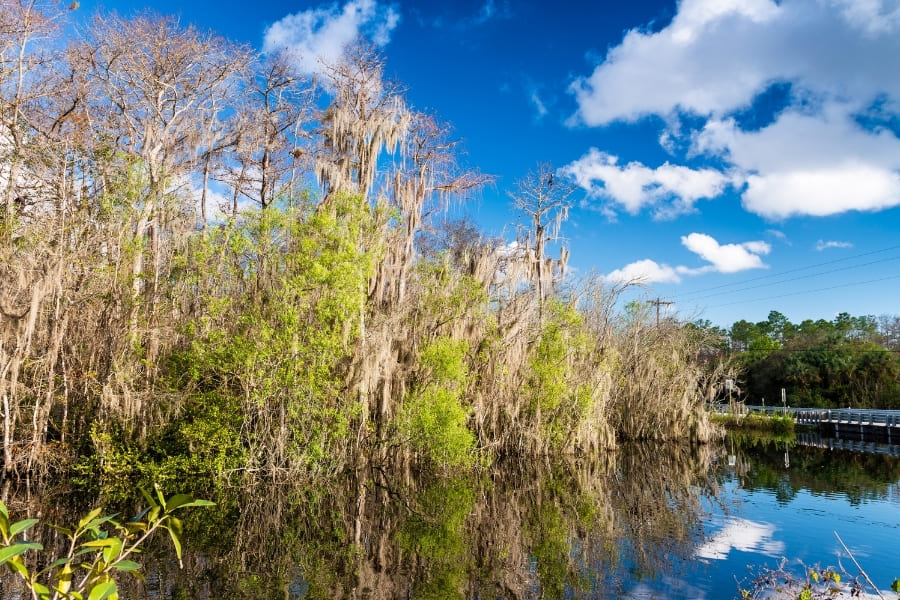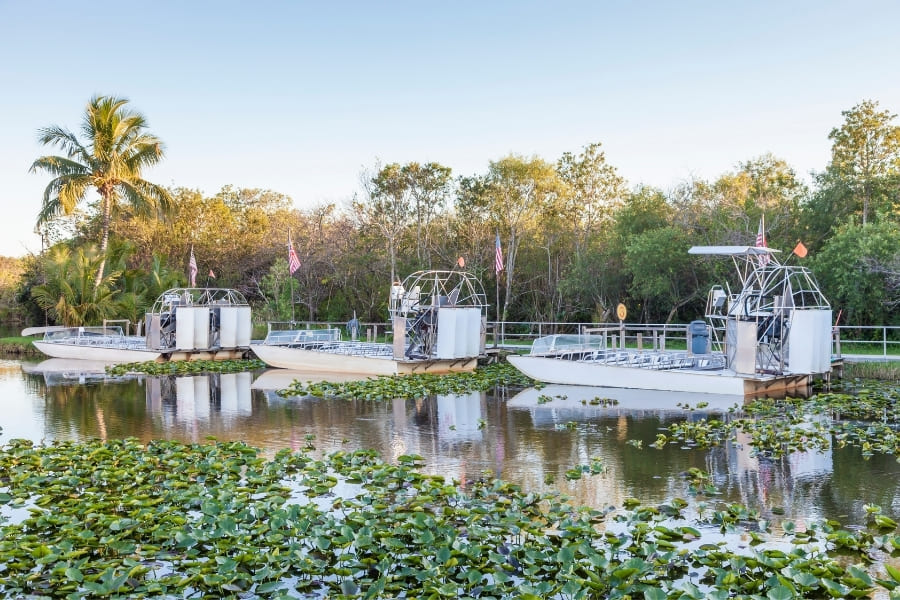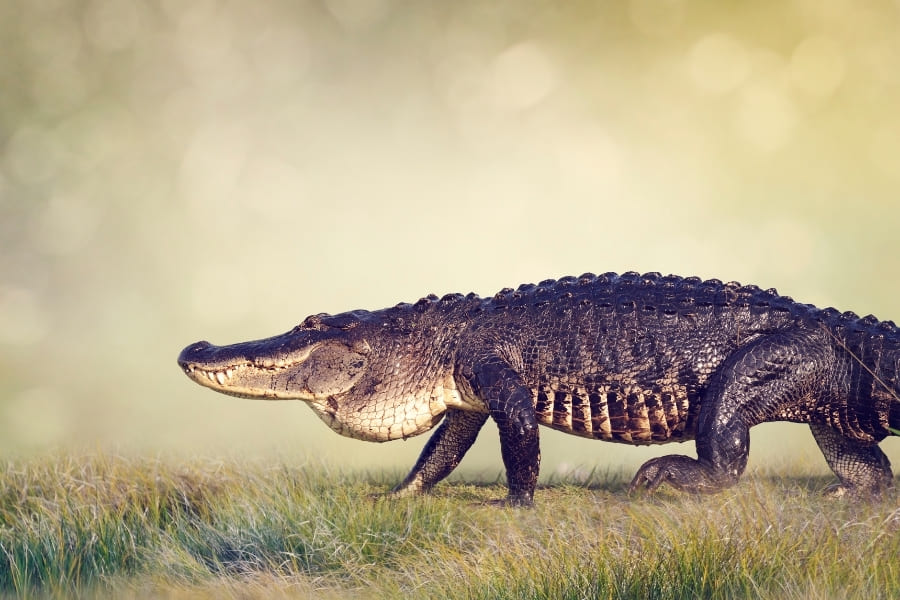The term Everglades describes an area that stretches from Lake Okeechobee in North Florida to the southern coast. Between these two the aptly named “River of Grass” flows through large stretches of prairie. During rainy season the river swells dramatically, turning the Everglades into a watery world with extensive canals and deltas.
This world is home to many animals, among them water birds like flamingos and herons, crocodiles, alligators, manatees and black bears. The state’s heraldic animal, the Florida Panther, also lives here, albeit in dwindling numbers. Coastal areas of the Everglades National Park are dominated by mangroves. These plants with their distinctive taproots filter ocean water and play a big role in Florida’s ecosystem. In the south, the meandering River of Grass empties into the Gulf of Mexico.

OPTIONS FOR YOUR TRIP TO THE EVERGLADES
There are many ways to explore the diverse natural wonders of the Everglades. Among them, airboats are the most popular option. These flat vessels with their iconic propellers have been immortalized by films and TV series like CSI Miami, and are perfect for navigating the waterways. Boat tours are available in many places such as the Everglades Safari Park situated between Shark Valley and Miami. Experienced captains will take you to the most beautiful spots, all the while sharing their knowledge about Everglades National Park.
Another well-established company is Captain Jack’s Airboat Tours. Guests can choose between labyrinthine mangrove forests and vast flooded grasslands. Captain Jack’s also offers Swamp Buggy Tours. The ride will take you through enchanted cypress forests and to a lake where you can spot Florida’s famous manatees. If you would rather paddle yourself, you can always book a kayak tour. Organizers like Everglades Area Tour transport guests to secluded spots in the National Park by motorboat, before it is time to launch the kayaks.
This silent, eco-friendly mode of transport is ideal for spotting shy animals like tortoises, snakes, eagles and even dolphins. Of course, you can also explore the National Park on your own. Boats and maps of the waterways can be rented in Flamingo or the Gulf Coast Visitor Center. One of the most popular routes is Nine Mile Pond – perfect if you want to experience the quiet atmosphere of the Everglades National Park and observe alligators in the brackish water.
Guests who wish to see yet another side of the Everglades should hike the National Park’s many trails. The Tamiami Trail is flanked by tall deciduous trees and runs along canals teeming with tortoises and alligators. The end of the trail is marked by the 66 feet tall Shark Valley Observation Tower that offers a perfect view over the River of Grass. The trail also features a curiosity amidst the undeveloped wilderness: Ochopee Post Office, the smallest of its kind in the USA. There is exactly enough space for one customer. Nonetheless, you can buy and send post cards here like you would in a regular post office. If you follow the Otter Trail, you might not only spot intriguing limestone caves but also the furry animals that gave the trail its name.
Shark Valley is also a perfect place for cycling, thanks to 15 miles of bike lanes overlooking the forested islands. If you want to explore the Everglades underwater, you should book a boat trip to the “Ten Thousand Islands” off the southwest coast of Florida. These islands are for the most part unpopulated and harbor more than 200 fish species. Baby fish in particular seek shelter between the mangrove roots. Situated at the National Park’s northern end is Okeechobee, Florida’s biggest lake and a favorite spot for perch fishers.
FLORIDA’S ALLIGATORS UP CLOSE
Alligators form an integral part of America’s pop culture, and the Everglades are the perfect spot to see them in the wild. The Everglades are also the only place on earth where the cold-blooded hunters share their habitat with crocodiles. Alligators mostly live in fresh water, hunting fish, tortoises and other aquatic species. They occasionally come ashore and are known to cross roads and hiking paths. While there is no need to be afraid of these prehistoric reptiles, a bit of caution is called for. Every year there are cases of alligator bites. The chances are minuscule – 1 to 2.4 million, to be precise. Nonetheless, you should heed the official warnings and never enter the water where you are not supposed to.
Baby alligators are a lot less imitating than their fully grown parents, and having your photo taken with a small gator is part and parcel of many airboat tours. Florida’s iconic reptiles not only live in the wild. They are also bred on special alligator farms. The biggest one is located in Homestead and houses 2.000 specimens. Here visitors can learn more about the reptiles and watch their feeding frenzy. The highlight, however, are the alligator shows, where trainers perform daredevil stunts with their 800 lbs pets. “Alligator Wrestling” not only looks nerve-wrecking, but also has a long tradition that dates back to Florida’s native inhabitants.
ENTRANCE FEES AND OPENING TIMES OF EVERGLADES NATIONAL PARK
The national park is open every day from 8 am to 4.30 pm. The entrances are located in Shark Valley and Homestead. Tickets cost 8–25 USD, depending on whether you explore the park on foot, by bicycle or by car. Annual passes are available for 40 USD.
DIRECTIONS TO EVERGLADES NATIONAL PARK
The part of the Everglades not used for agriculture belongs to the Everglades National Park, a 1.508.976 acres area that was put under protection in 1947. It takes about 1 hour by car to get to the park from Miami. Driving from Fort Myers to the western part of the park, you will need 1.5 hours, while guests based in Cape Coral should plan for a 2 hours drive.
CLIMATE AND WEATHER IN THE EVERGLADES
The national park is open the whole year round, but the months of October to April are considered the best traveling time. Then, the water that floods most of the park in summer retreats. Animals are forced into small pockets and can be observed more easily. What is more, mosquitoes are less of a pest in the dry season. Thanks to moderate humidity and low chances of rain, the month of May is a good compromise. Compared to the winter months, fewer people visit the park at that time.
CLIMATE CHART EVERGLADES
All details on the climate chart of the Everglades.








